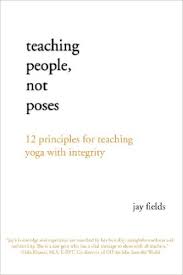 Jay Fields started teaching yoga at a very young age. The gymnast-turned yogini was only 18 when she first led students through poses. Predictably, she wasn’t sure what she was doing. But 14 years later, she’s condensed her wisdom about teaching into a tiny gem of a book. Teaching people, not poses: 12 principles for teaching yoga with integrity weighs in at less than 80 pages, but packs scads of 100 percent bullshit-free advice.
Jay Fields started teaching yoga at a very young age. The gymnast-turned yogini was only 18 when she first led students through poses. Predictably, she wasn’t sure what she was doing. But 14 years later, she’s condensed her wisdom about teaching into a tiny gem of a book. Teaching people, not poses: 12 principles for teaching yoga with integrity weighs in at less than 80 pages, but packs scads of 100 percent bullshit-free advice.
Jay offers group and private classes from her home base in Ojai, California. She also runs the website Grace & Grit, which offers resources to teachers. She believes the point of practicing yoga, and of teaching yoga, is to become more ourselves. She wants us all to be more present in the moment and rooted in our bodies.
Of course, obstacles prevent us from being as present and rooted as we might want to be. Chief among these are our expectations of what we should be and our perceptions of what others expect from us. For yoga teachers, this means we can run into some cringe-worthy clichés. Jay nails some of my pet peeves, including the yoga teacher voice. She mentions almost leaving a vinyasa class “where the teacher said ‘downward facing dog’ as if she were a cheesy sportscaster on the evening news…Do you know how many times a teacher says downward facing dog in the course of a vinyasa class?”
 Even worse is the received but undigested spiritual knowledge. Jay warns: “Your students can sense when you’re regurgitating something you read or are just channeling a spiritual teacher’s words. And if your students are anything like me, it kind of makes them want to throw up.”
Even worse is the received but undigested spiritual knowledge. Jay warns: “Your students can sense when you’re regurgitating something you read or are just channeling a spiritual teacher’s words. And if your students are anything like me, it kind of makes them want to throw up.”
So what’s a yoga teacher to do? Jay covers the voice and the spiritual knowledge in principles 1 and 4, “be yourself” and “teach from your own experience.”
Students are looking for more than a sequence of poses when they come to yoga class, Jay says. They want connection. And if they’re coming to your class regularly, they want to connect with you. This means letting them see your humanness and vulnerability. Jay discusses the territory a teacher navigates between being human and being professional. She shares her vulnerability with her classes by admitting that she’s scared about something in her life or needs a good cry. But she doesn’t go into the back story of her messy breakup and personal regrets or whatever else is bothering her.
This can be a fine line. Because it’s not just the students who feel connected to the teacher. The teacher feels connected right back.
Most yoga teachers are caretakers, Jay says. So when we walk into a room we can feel responsible for the physical and emotional well-being of our students. Which can feel overwhelming. In principle 11, “remember who and what supports you,” she discusses various forms of support for teachers, from the ground we’re standing on to whatever our conception of the divine.
Jay’s writing is wonderfully easy to read. It’s spare, honest and to the point. She doesn’t hesitate to share embarrassing moments when they might help readers avoid the same. I especially liked her story in principle 12, “don’t try to please everyone,” about how student feedback has changed as she’s become more confident in her teaching. Early in her teaching career, she was very uncertain. Students constantly suggested ways to improve her class and teaching, and she tried to accommodate them all. Over the years this decreased to the point where she now feels secure in what she’s teaching. If students don’t like it, they don’t return to her class. She no longer gives off a vibe like she’s needy for their input.
Yoga teachers at all experience levels will enjoy reading this book, even though there will probably be points where they freeze and recognize themselves in a less-than-stellar teaching example. Busted! Newer teachers will benefit even more.



